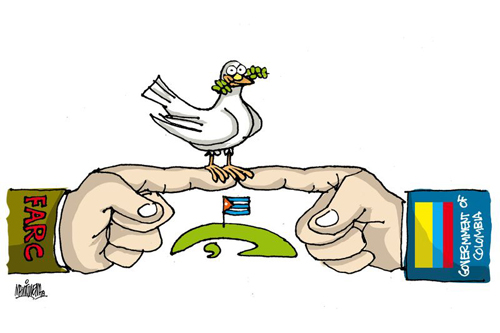
Discussions which started last November in Oslo, Norway, between the Revolutionary Armed Forces of Colombia (FARC) and the Colombian government continue in Cuba. Central to the agenda are: land redistribution; a secure and open electoral process to allow FARC’s political representatives and allies – the 10-year-old underground Bolivarian Movement for a New Colombia (MBNC) – to campaign for office; a national solution to the production and sale of cocaine, and compensation for war victims. At the start FARC declared a ceasefire, yet the government refused to reciprocate. Under continued attack in the field FARC returned fire from 20 January 2013, while remaining open to a bilateral truce. The discussions continued.
For 50 years the ruling class has attempted to cheat, seduce and butcher its way to an impossible victory over the FARC, including two previous long periods of negotiation, and has come to realise that it simply cannot defeat it, and smaller revolutionary groups like ELN, by force. FARC has struggled for 50 years to defend the peasants of Colombia from violent expulsion from their plots by large landowners and in so doing to create a genuinely democratic state. FARC has constantly sought peaceful negotiations in the face of state attempts to exterminate all armed defence of the small peasantry, landless workers and indigenous peoples.
The highest number of internally displaced people in the world
Despite FARC’s resistance, vast tracks of land are now held by agricultural capital in Colombia, which has the greatest concentration of ownership in the world: 52% of arable land is owned by 1.5% of landowners. As a result, for the fourth year running, Colombia has the highest number of internally displaced people in the world – between 4.9 million and 5.5 million, and it is predicted that this will continue at an accelerated rate unless permanent solutions to the conflicts are found. These figures do not include those displaced as a result of violence carried out by criminal and drug-trafficking gangs. Swept from the land, the homeless camp in slums on the edges of the larger towns deprived of all dignity. Jorge Restrepo, the director of Colombia’s Conflict Analysis Resource Centre, says that, since the talks began, ‘We have seen an intensification of violation of human rights of indigenous and Afro-Colombian communities and human rights defenders’.
FARC wants 25 million hectares (62 million acres) of land, more than 20% of the country, to be given to the poor and a limit on how much property big landowners can have. The government has insisted no land will be taken from private landowners, but acknowledged that rural development and distribution of land are key to achieving peace. The ranchers, with vicious former president Alvaro Uribe as their spokesman, absolutely oppose any reconciliation with the FARC or redistribution of land stolen by big capital from the now millions of landless. This provides President Santos with an excuse to slow up discussions over current-day land redistribution, even though the government had already declared a programme of land compensation in the run-up to the current negotiations. In April the government spokesman, Humberto de la Cale, announced that an agreement had been reached over land reform; this was confirmed in May by FARC, but no details have been given. Unlike in the previous election in 2010, the FARC have not at this point directly opposed Santos’ preparations to launch his presidential candidacy for 2014. FARC’s political programme for the 2014 presidential election will depend on an accord being reached with Santos on agrarian reform and political participation.
The demand for peace
On 10 April, – the anniversary of the 1948 assassination of left-wing presidential candidate Jorge Eliecer Gaitan – tens of thousands of Colombians demonstrated in Bogota, Cali and Santander in support of the peace process. The event was organised by the grassroots ‘Patriotic March’ as an act of solidarity with FARC negotiators. Significantly, it included survivors of the ‘Patriotic Union’, FARC’s successful 1984 initiative at forming a political party that, as it campaigned openly and legally for the 1986 elections,was subsequently virtually exterminated by the ruling class. The march was joined by President Santos in an attempt to upstage the organisers by presenting himself as the ‘real’ peace leader.
Santos needs to be seen to be meeting the public demands of the US, and get rid of those exposed as the most savage supporters of the extermination policies carried out in the past. He represents the wider commercial classes in Colombia, not simply the agricultural and drug barons. Four high-ranking former military officials are currently ‘under investigation’, following a UN report that under the Uribe government of 2002-2010, Colombia’s armed forces murdered 4,000 civilians whom they then dressed up as guerrillas to pretend their institutions were ‘effective’, a practice euphemistically dubbed ‘false positives’. So far no Colombian general has been charged with complicity in the mass executions of civilians that became so common that in 2007 at least one in five reported combat kills was in fact a murdered civilian. Since the breaking of the scandal in 2008, thousands of non-ranking members of the armed forces have been charged with homicide, but only a few hundred have ever been convicted.
Alvaro Michaels




